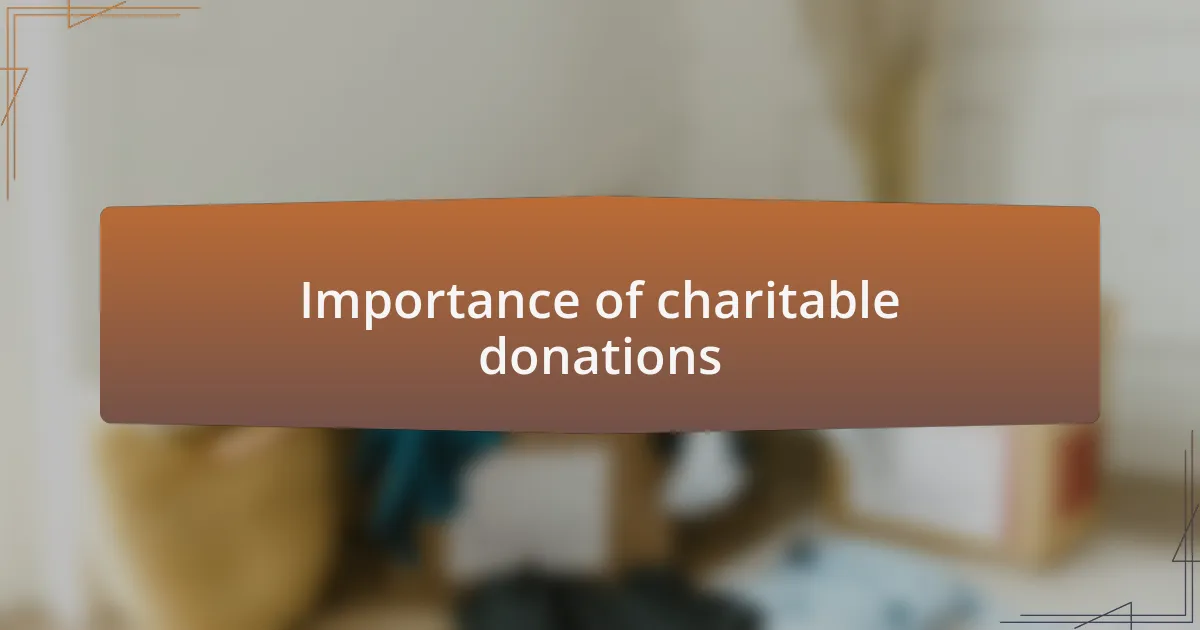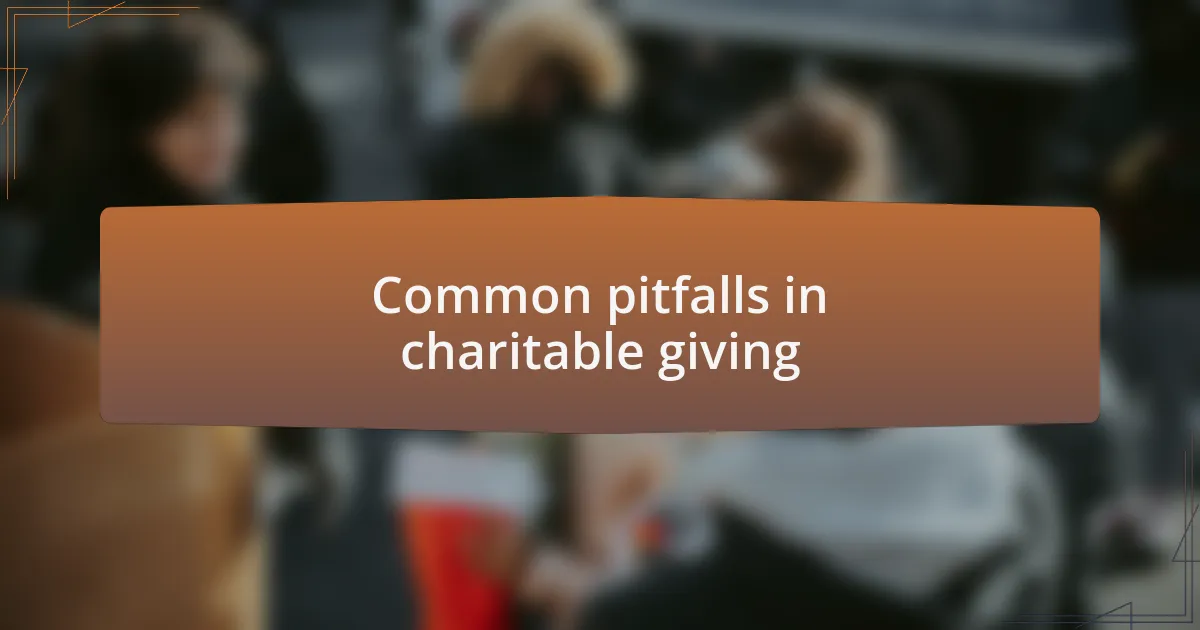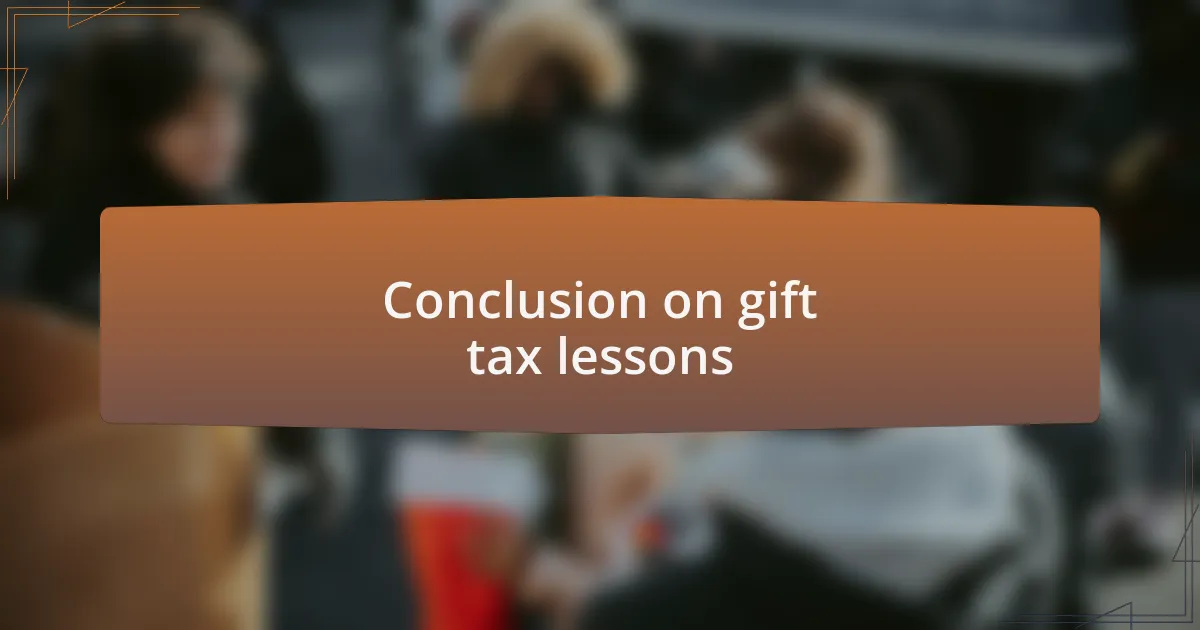Key takeaways:
- The annual exclusion limit for gift tax in 2023 is $17,000 per recipient, which should be considered when planning significant gifts.
- Charitable donations not only provide support to those in need but can also inspire others to contribute, creating a ripple effect of generosity.
- Understanding tax implications, such as deductions for charitable gifts, can enhance both financial benefits and philanthropic impact.
- Common pitfalls in charitable giving include failing to research organizations, misinterpreting tax deductibility, and inadequate planning regarding donation timing.

Understanding gift tax
Gift tax can initially seem confusing, but understanding it is crucial for anyone considering transferring wealth to others. When I first learned about gift tax, I remember wondering why I had to think about taxes for something as generous as giving money or property. But the reality is that the government imposes a tax on certain gifts to ensure that wealth is fairly distributed and not sheltered from taxation.
One of the most surprising insights I encountered was the annual exclusion limit. This is the maximum amount you can gift to someone without incurring any gift tax, which for 2023 is $17,000 per recipient. I recall the moment a friend told me how he planned to gift his children significant amounts, and I had to remind him of this limit to avoid any tax headaches.
It’s intriguing to consider how gift tax can influence decisions about generosity. For instance, if you’re thinking of helping a loved one with a down payment on their new home, should you gift them the entire amount or break it into smaller gifts over several years? This kind of strategic thinking often crosses my mind as I balance my desire to give freely with the implications of tax regulations. It’s important to approach your philanthropy not just with kindness but with awareness of these financial guidelines.

Importance of charitable donations
Charitable donations hold immense significance in our society. When I decided to contribute to local shelters, it opened my eyes to the profound difference a single contribution can make. It’s not just about the money; it’s about the hope and support we provide to those in need, making our communities stronger and more resilient.
I’ve often thought about how donating to charities can also inspire others to follow suit. It’s fascinating to see a ripple effect where a small act of kindness can encourage those around us to contribute as well. Have you ever experienced that moment when a simple donation sparks a broader movement? It’s a beautiful reminder that generosity is contagious and can transform lives in unexpected ways.
Moreover, I’ve come to appreciate the emotional impact that charitable giving brings. At times, when I felt overwhelmed by the challenges of life, volunteering and donating reminded me of our shared humanity. It creates a connection that transcends our individual struggles, reminding us that together, we can overcome significant challenges. It’s that sense of belonging and purpose that makes charitable donations invaluable.

Tax implications of charitable gifts
When it comes to charitable gifts, understanding the tax implications can feel daunting. I remember the first time I made a significant donation; I was pleasantly surprised to discover that not only was I supporting a cause I cared about, but I could also deduct that gift from my taxable income. It’s a win-win situation that can turn an act of generosity into a financially savvy decision.
But how do these deductions actually work? In my experience, the IRS allows you to deduct contributions to qualified charitable organizations, often up to 60% of your adjusted gross income. It’s essential to keep records of your donations and obtain a receipt for gifts over a certain threshold. Have you thought about what happens if your donation exceeds that threshold? You can carry forward the excess amount to future tax years, which is a handy feature I’ve utilized in my own giving journey.
Another important point to consider is the difference between cash and non-cash donations. While cash gifts are straightforward, donating items like clothing or art can sometimes yield higher deductions. Personally, I once donated a piece of furniture that I no longer needed and, to my surprise, the value of the deduction was much greater than I anticipated. These small strategies can make a significant difference, allowing you to amplify your impact on the causes you care about while also exploring the benefits for your financial situation.

Strategies for maximizing gift deductions
When it comes to maximizing gift deductions, timing can play a crucial role. I once learned that making my charitable contributions at year-end can be strategically advantageous. This timing allows me to ensure my donations are eligible for that tax year, as it’s easy to forget how quickly the clock can run out on valuable deductions. Have you ever rushed at the last minute to make a donation just to squeeze it in for the tax benefits? Trust me; it’s a common scenario!
Another effective strategy is to consolidate your charitable giving through a donor-advised fund. This approach lets you contribute a lump sum in one year, which can help exceed the threshold for itemizing deductions. I remember the clarity I felt after my first consolidation—seeing all those deductions add up truly transformed the way I approached my philanthropic efforts. Imagine getting that warm feeling of generosity and knowing it’s also working in favor of your tax situation!
Additionally, involving family members in your charitable giving can amplify both your impact and your deductions. Just a few months ago, my siblings and I teamed up to donate to a local shelter. Not only did we strengthen our bond through a shared charitable goal, but we also maximized our collective deductions. Engaging others not only enriches the experience but can also significantly boost the amount you can claim on your taxes. How often do we consider the power of community in our giving journey? It can elevate both the joy of giving and the financial benefits that come with it.

Personal experiences with gift tax
Navigating the gift tax landscape can feel overwhelming, but my own experiences have clarified a lot. A few years ago, I made a sizable gift to a nonprofit I truly believed in, only to later discover that I had crossed the lifetime exemption threshold without realizing it. That revelation was a bittersweet reminder of how important it is to stay informed—how many of us have learned the hard way that ignorance can be costly?
One specific moment sticks with me: I was at a family gathering, discussing my recent charitable contributions when a relative asked about the implications of gift tax. How could I advocate for giving without addressing the potential pitfalls? That conversation led me to dive deeper into the tax implications, transforming my initial excitement into a sense of responsibility. It illuminated the connection between my goodwill and the legal landscape surrounding it—one I hadn’t fully appreciated before.
I also found that tracking my gifts throughout the year became essential. For instance, I started using a simple spreadsheet to log my donations and their values, which not only organized my records but also helped me feel more accountable. It made me realize that paying attention to the numbers could amplify my philanthropic impact while navigating the intricacies of tax laws. Have you had moments where the logistical side of giving taught you something invaluable? It certainly reshaped my approach to generosity.

Common pitfalls in charitable giving
When it comes to charitable giving, one of the most common pitfalls is failing to research the organization. I recall donating to a cause that seemed noble; however, I later discovered that their financial transparency was questionable. This experience left me feeling disillusioned. I began to wonder: how often do people give without truly understanding where their money goes? It’s vital to vet charities to ensure they align with your values and use funds effectively.
Another issue I encountered was the misconception that all donations are tax-deductible. In my early philanthropic days, I made several contributions, assuming I could write them off. It wasn’t until I audited my receipts that I realized some were not eligible for deductions. It’s a good reminder that understanding tax laws isn’t just for tax season—it affects how we give throughout the year. Have you double-checked the deductibility of your own contributions?
Lastly, I once underestimated the importance of timing in philanthropic efforts. I made a generous end-of-year donation, thinking it would maximize my tax benefits in that calendar year. Yet, the lack of planning ended up overshadowing a more strategic approach, like setting up recurring monthly contributions. It taught me that the way we give can be just as important as the amount. Do you give with intention? Reflecting on your timing can shape the impact of your generosity over the long term.

Conclusion on gift tax lessons
Understanding the nuances of gift tax has been a profound learning curve for me. I used to think gifting would simply enhance my charitable efforts without any repercussions. However, realizing that certain donations can trigger gift taxes made me reflect on both my generosity and my financial strategy. Have you ever considered how the tax implications could shape your charitable endeavors?
Additionally, I’ve come to appreciate the importance of financial planning in making charitable gifts. I remember when I wanted to contribute a significant amount to a charity; I didn’t account for the gift tax threshold. That oversight not only impacted my budget but made me reconsider how much I could responsibly give while still maximizing my benefits. It’s a lesson that proactive planning isn’t just wise; it’s essential for making the most of your philanthropy.
Ultimately, navigating gift tax intricacies has deepened my perspective on meaningful giving. I now approach it with a more informed mindset, realizing that my choices can influence not just the recipients but my financial health as well. Have I shifted my approach? Absolutely. Learning about gift tax has turned my focus into a more strategic and impactful journey, where every gift feels intentional and beneficial.